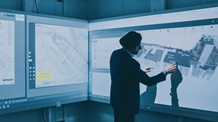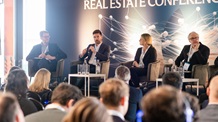Perspectives
Is tech-enabled design the answer to future-proofing the workplace?
As part of their 2022 digital strategy, the UK Government recently proclaimed the UK as the best location in the world to start and build a technology business. But in the current climate, how can an office, technology-focused or otherwise, be one that is testament to that assertion – an office that continues to inspire and retain staff, while at the same time meeting the demands of employees working remotely?
The answer may just be found in the tech sector. While every organisation’s needs are unique, when it comes to creative and forward-thinking workspaces, big tech corporates are raising the bar - with many even incorporating their own tech into the fit-out design and delivery approach.
Designed to deliver
Technology should form the centrepiece of every workspace - not only driving the design concept, but also acting as the basis of an ecosystem that allows a workforce to thrive and perform.
The pandemic shone a light on the need for increased flexibility, and with fixed desks quickly becoming a thing of a past. Hot desking and open plan spaces have become the new norm, with companies investing in multifunctional spaces that embody their culture, ethos and brand. However, no two companies are the same and how a workplace develops often all depends on a company’s overarching mission.
For example, we have observed that an estimated 70% of data-led companies often lean more towards audiovisual zones, meeting spaces that facilitate collaboration, with catering areas that create hotspots for teams to meet and organise informal meetings. This differs to that of retail, media and manufacturing focussed companies who often require a much more traditional layout that better reflects the environment they need to carry out their high-performance duties. Smaller acoustic meeting pods for up to two people are also highly desirable for their ability to facilitate focused work and private calls.
The lessons learnt from the tech sector’s approach to work are in creating a diversified environment that promotes a personalised experience and one that suits every employee now and for years to come. Infusing versatile tech into office design and furniture, such as LED walls, can shape how employees engage and work efficiently, promoting teamwork and advancing digital skills to help accomplish high quality work. Digital design can support employees to create and do their best work, especially in such a fast-paced environment where they are required to keep their finger on the pulse to constantly stay abreast of upcoming trends.
Enhanced user experience
When it comes to employee wellbeing and productivity, enlisting advanced technology is a must in enhancing the office experience. Nearly 80% of workers are now using collaboration tools for work. Therefore, adopting a solid infrastructure from the outset, with multiple touchpoints, can help to unite both employees and clients working remotely and in office.
Tech companies are at the forefront of immersive solutions that can help to form a bridge between office-based and remote employees - even those based across different floors within the same building. High-quality video and audio equipment, supporting data, video streams, virtual reality conferencing and 360-degree content in real-time are all such ways of building that bridge, supporting high level interactivity and while still offering a human touch.
Another such touchpoint is the introduction of technology, also allowing for more nuanced control of an office environment. This technology can be integrated within a structure and can effectively optimise a range of areas – from heating and lighting to monitoring energy consumption through desk modules, as well as providing USB-C power through meeting room tables, with wireless energy consumption feedback - not to mention air quality sensors and occupancy monitors, all at the touch of a button.
A recent Mace client who sought high level functionality and improved space utilisation, requested integrated desk sensors on every hot desk to help determine the capacity of the space. This offers real-time insights into occupancy and activity levels, allowing employees to book desks and keep abreast of who will be working in the office and who will be working from home on any given day.
Protection of intellectual property can also be paramount, particularly for many of our tech clients who have dedicated departments that deal with different software. Confidentially between teams is vital and this can be aided by delivering exclusively divided zones, so taking Apple as an example, if one team are working on the technology associated with Apple Pay, then they must be disconnected from a team working on SIRI upgrades.
Shaping company culture
One of the major ways in which tech clients differ when it comes to workspace, is in how they choose to incorporate their mission and key drivers into their work environment. The fast paced, entrepreneurial nature of companies in the field of Technology, Media and Telecommunications (TMT), mean that they are quick to respond and adopt new office trends to meet the changing nature of office life. Their goal is to blur the boundary of work and play; as a result, larger TMT organisations demand at least half of their floor space be dedicated to areas where employees who balance work-from-home with the office can socialise and brainstorm more organically, thanks to zones that don’t feel too far from home with relaxed settings and softer characteristics that mimic these familiar environments.
Brands who sit in the TMT space also often propose strong design guidelines and standards to create a synonymous look and feel across their global offices. This type of brand activation is in increasingly high demand and can be translated through bespoke customisation – i.e. incorporating elements of a brand’s logo into furniture and wall panelling.
In one of our recent design and build projects for a $50 billion short-form video app, we installed the largest LED wall in Europe to echo the brand’s mission. This feature is integral to the workspace and successfully fulfills its purpose of bringing staff together to collaborate creatively in a dynamic and energising setting. Similarly, we predict that we will see a rise in audio and video-enabled apps that support the different forms of engagement and tasks common in hybrid work, as the work model continues to spike.
Keeping pace with intelligent space
Tech companies are already investing in new digital tools and processes to enhance their offerings and it’s clear that other sectors are set to follow suit. We predict that the demand for smarter working solutions - like the Internet of Things (IoT), machine learning and AI – will increase in volume, with even more sophisticated facility management tools introduced to help support and transition to newer and complex flexible methods of working. All have far-reaching benefits for both occupants and the environment, in their ability to facilitate agile working, alleviate high traffic areas, optimise health and wellbeing, as well as reducing energy intensity through using alternative sources of power.
Through technology, offices must be reimagined to compete with home comforts, and in order to create an environment that is efficient, comfortable, and engaging. Of course, delivering this concept at scale will prove challenging - particularly when keeping pace with a company’s expansion plans – but the future of the workplace is happening now. How will your workspace stay ahead of the curve in this new era?
I want a better perspective on











